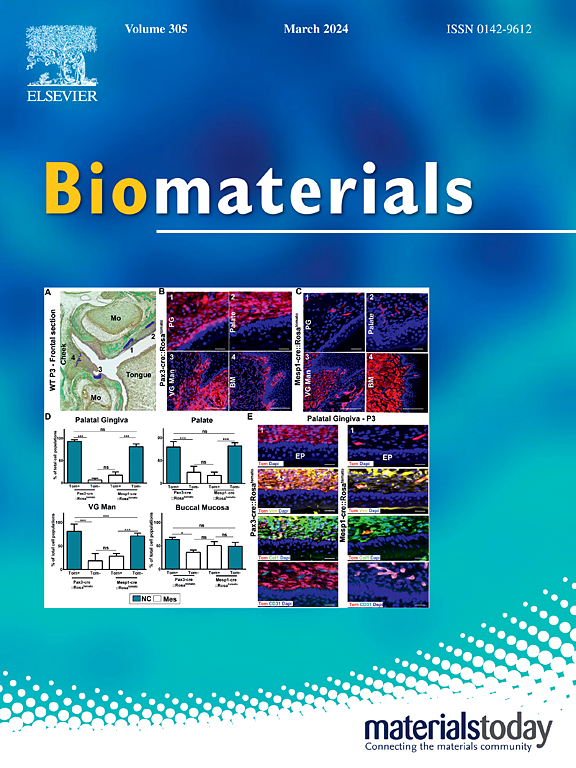基于生物3D打印微流体的骨肉瘤芯片模型作为抗癌药物的仿生临床前药物测试平台
IF 12.8
1区 医学
Q1 ENGINEERING, BIOMEDICAL
引用次数: 0
摘要
骨肉瘤(OS)治疗的标准化疗方案往往导致治疗效果不佳,这主要是由于缺乏反映原生OS结构和细胞复杂性的适当代表性模型,从而造成了转化方面的空白。三维生物打印(3D-BP)是精确再现骨肿瘤微环境(TME)结构和细胞复杂性的高效先进技术。在本研究中,我们采用了一种基于双重挤压的 3D-BP 方法,建立了一种由肿瘤和基质成分组成的改良体外 OS 模型。此外,我们还引入了人体仿生微流控生物反应器,以模拟动态 TME 并为细胞提供生理相关的机械刺激。经体外研究验证,该模型与原生 OS-TME 非常相似,被命名为 TC-OS 动态模型。连续介质流提供了剪切应力形式的机械刺激,对 OS 的生长和侵袭性产生了积极影响。此外,与 TC-OS 静态模型相比,用模型抗癌药物(多柔比星、顺铂、索拉非尼)进行的药物筛选表明,TC-OS 动态模型的灵敏度更高,这强调了连续介质流增强了抗癌药物的传质、可用性和分布。总之,TC-OS 动态模型作为未来高通量临床前筛选抗癌药物的平台,具有巨大的潜力。本文章由计算机程序翻译,如有差异,请以英文原文为准。

3D bioprinted microfluidic based osteosarcoma-on-a chip model as a physiomimetic pre-clinical drug testing platform for anti-cancer drugs
Standard chemotherapeutic regimen for osteosarcoma (OS) treatment often leads to poor therapeutic outcome, primarily due to lack of an adequate representative model reflecting native OS structural and cellular complexity, posing a translational gap. Three-dimensional bioprinting (3D-BP) represents an efficient and advanced technique for precise recapitulation of the structural and cellular complexity of OS tumor microenvironment (TME). In the present study, we employed a dual extrusion-based 3D-BP method to develop an improved in vitro OS model consisting of both tumor and stromal components. Additionally, a human physiomimetic microfluidic bioreactor is introduced to mimic the dynamic TME and provide physiologically relevant mechanical stimulation to the cells. The model named TC-OS Dynamic model, demonstrated close resemblance to native OS-TME, validated by in vitro studies. Continuous media flow provided mechanical stimulation in the form of shear stress, positively influencing the growth and aggressiveness of OS. Further, drug screening with the model anticancer drugs (doxorubicin, cis-platin, sorafenib) demonstrated enhanced sensitivity in TC-OS Dynamic model as compared to TC-OS Static model, emphasizing enhanced mass transfer, availability and distribution of anticancer drug due to continuous media flow. Overall, TC-OS Dynamic model holds significant potential as a platform in future for high throughput pre-clinical screening of anticancer drugs.
求助全文
通过发布文献求助,成功后即可免费获取论文全文。
去求助
来源期刊

Biomaterials
工程技术-材料科学:生物材料
CiteScore
26.00
自引率
2.90%
发文量
565
审稿时长
46 days
期刊介绍:
Biomaterials is an international journal covering the science and clinical application of biomaterials. A biomaterial is now defined as a substance that has been engineered to take a form which, alone or as part of a complex system, is used to direct, by control of interactions with components of living systems, the course of any therapeutic or diagnostic procedure. It is the aim of the journal to provide a peer-reviewed forum for the publication of original papers and authoritative review and opinion papers dealing with the most important issues facing the use of biomaterials in clinical practice. The scope of the journal covers the wide range of physical, biological and chemical sciences that underpin the design of biomaterials and the clinical disciplines in which they are used. These sciences include polymer synthesis and characterization, drug and gene vector design, the biology of the host response, immunology and toxicology and self assembly at the nanoscale. Clinical applications include the therapies of medical technology and regenerative medicine in all clinical disciplines, and diagnostic systems that reply on innovative contrast and sensing agents. The journal is relevant to areas such as cancer diagnosis and therapy, implantable devices, drug delivery systems, gene vectors, bionanotechnology and tissue engineering.
 求助内容:
求助内容: 应助结果提醒方式:
应助结果提醒方式:


